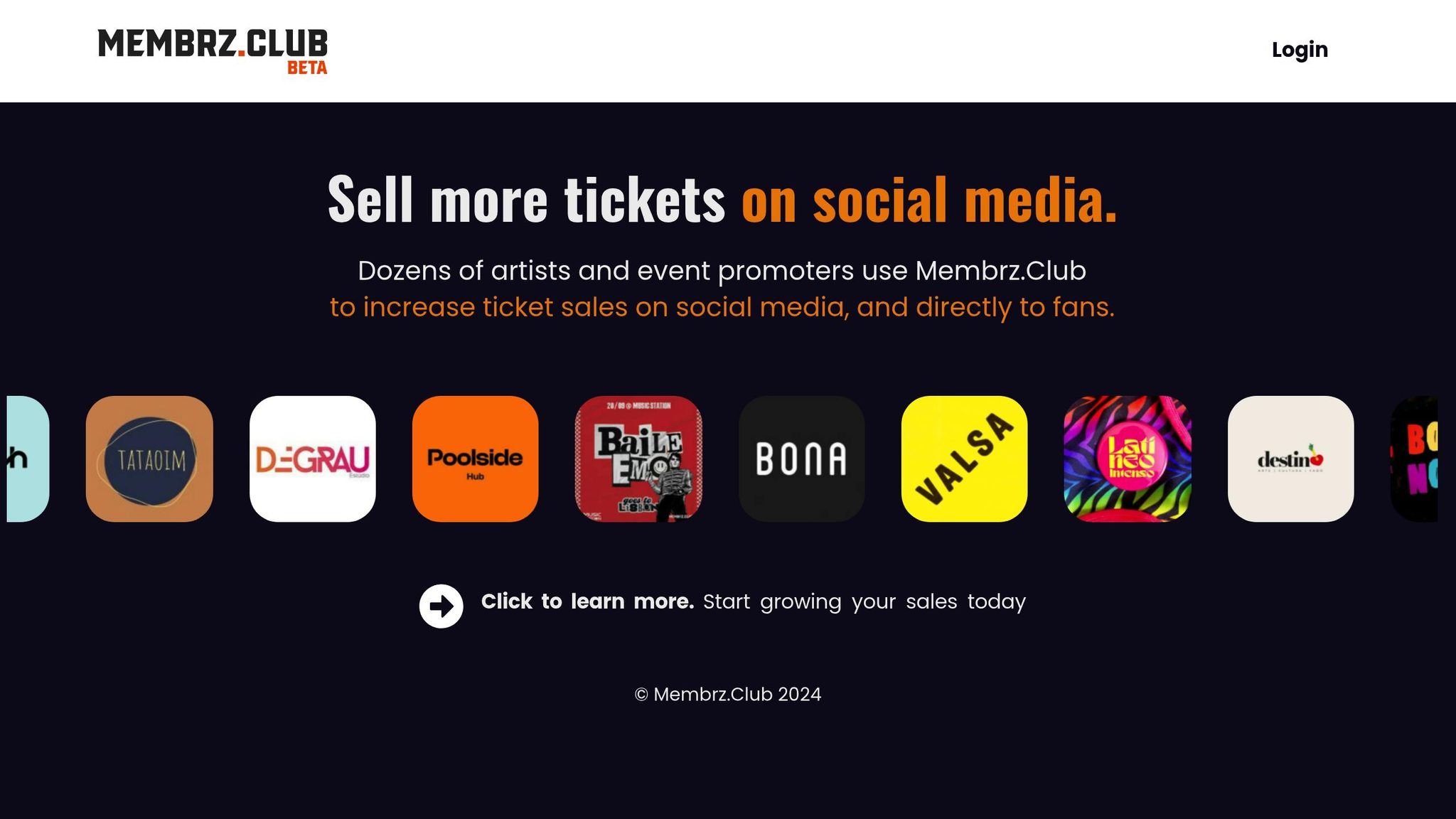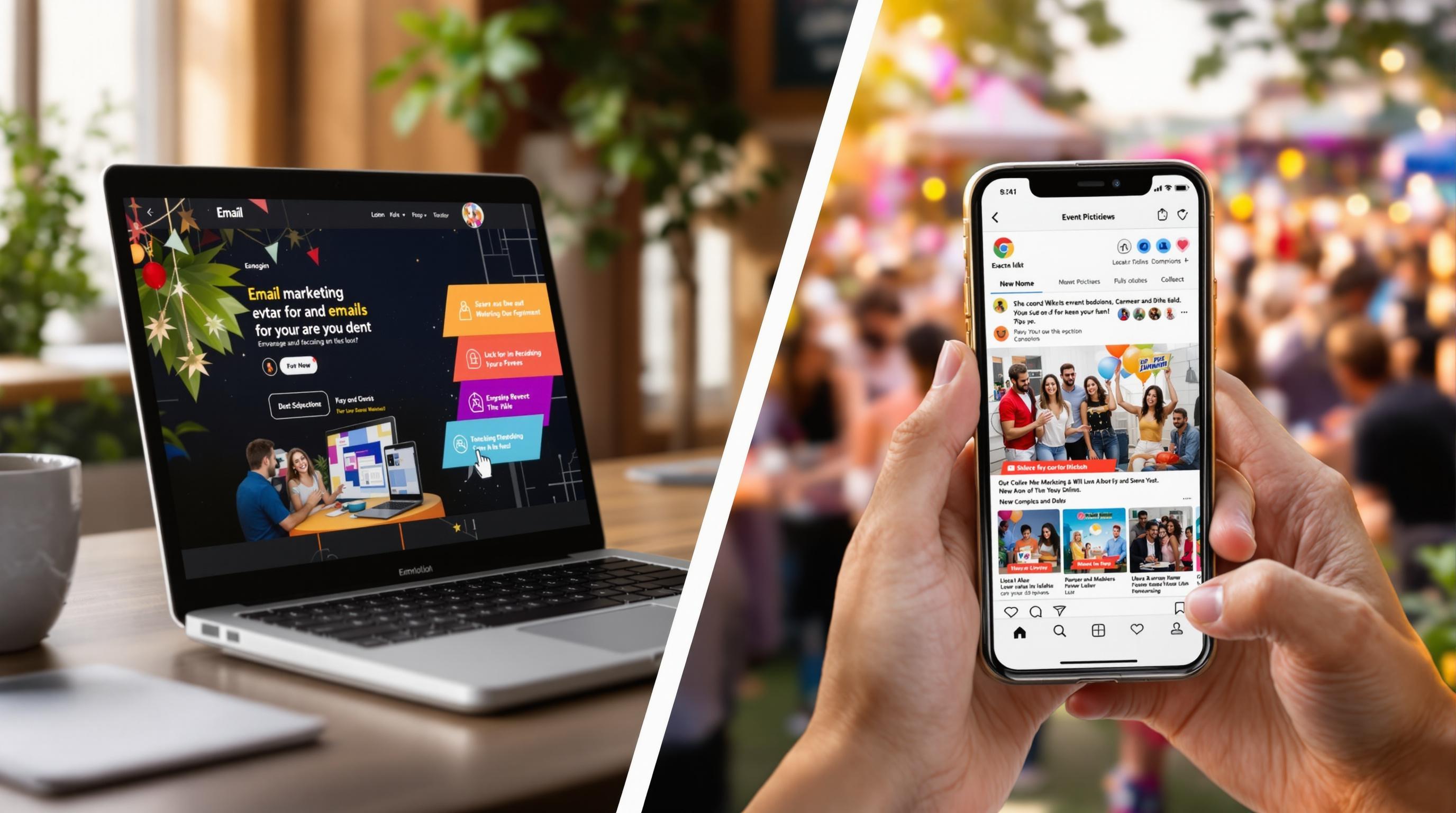UTM links help track where your event traffic and ticket sales come from. They’re URLs with added parameters that show which platforms and campaigns perform best. Here's what you need to know:
- What are UTM links? URLs with tags like
utm_source(platform),utm_medium(channel), andutm_campaign(campaign name) to track marketing performance. - Why use them? Gain insights into ticket sales, audience behavior, and ROI for smarter event marketing decisions.
- How to create them? Use free tools like Google’s Campaign URL Builder to generate UTM links by adding source, medium, campaign name, and optional tags.
- Tips for success: Use lowercase, avoid spaces, and include date markers for recurring events.
Example: A link with utm_source=instagram&utm_medium=social&utm_campaign=summerfest_2025 shows how Instagram drives ticket sales for your event.
UTM links are especially useful for A/B testing, comparing platforms, and tracking multiple events. Start using them to measure performance and improve your marketing strategies.
Tutorial: UTM Tracking for Portfolio & Landing Pages (Linktree, Wix, Notion, etc.)
Creating UTM Links: Step-by-Step
Setting up UTM parameters correctly is crucial for tracking your event marketing efforts. Here’s a quick guide to the tools and naming conventions you’ll need.
Free Tools for UTM Link Creation
Here’s how you can create UTM links using a free tool:
- Step 1: Go to Google's Campaign URL Builder.
- Step 2: Enter your main event landing page URL.
- Step 3: Fill in the required fields:
- Campaign Source (e.g., instagram, facebook)
- Campaign Medium (e.g., social, paid)
- Campaign Name (e.g., summer_fest_2025)
- Step 4: Add optional parameters like content and term tags for more detailed tracking.
- Step 5: Copy the generated URL for use in your campaigns.
If you’re using Membrz.Club for event promotion, the platform simplifies tracking directly through your event dashboard.
UTM Parameter Naming Guidelines
To ensure consistency and accuracy, follow these naming conventions when setting up UTM parameters:
| Parameter Type | Format | Examples for Events |
|---|---|---|
| Source | platform_name | instagram, tiktok_organic |
| Medium | traffic_type | social, email, cpc |
| Campaign | event_name_date | summerfest_may2025 |
| Content | placement_type | story_link, bio_button |
| Term | keyword_focus | early_bird, vip_tickets |
Tips for UTM Parameter Creation:
- Stick to lowercase: Using lowercase ensures consistency and avoids tracking errors.
- Avoid spaces and special characters: Replace spaces with underscores and remove special symbols.
- Add date markers for recurring events: This makes it easier to compare performance across different event dates.
With these steps and guidelines, you’ll be able to track your event marketing efforts with precision.
UTM Links in Link-in-Bio Pages
UTM parameters can be a game-changer for tracking how your audience interacts with your Link-in-Bio page. By applying these parameters, you can monitor performance in real time and make smarter decisions.
Adding UTM Links in Membrz.Club

UTM tracking allows you to measure how well your event campaigns are performing directly from your Link-in-Bio profile. Membrz.Club simplifies this process with built-in tools that track audience behavior and ticket sales.
-
Set Up Event-Specific UTM Parameters
Assign unique UTM parameters for each event. Make sure to include details like:- Campaign name (e.g., event identifier)
- Source (e.g., Instagram, TikTok)
- Medium (e.g., organic, paid)
- Content (e.g., bio_link, story_swipe)
-
Configure the Analytics Dashboard
Activate the dashboard to track key metrics, such as:- Ticket sales by source
- Click-through rates
- Audience engagement
- Revenue attribution
Tracking visits, clicks, interactions, and time spent on your page provides valuable insight into how fans engage with your content on Membrz.Club.
Managing Multiple Events with UTM Links
If you're running several events, structured UTM parameters can help you stay organized and track performance effectively.
| Event Type | UTM Structure | Focus |
|---|---|---|
| Regular Shows | event_name_mmyy | Weekly performance |
| Festival Series | festival_name_season | Seasonal comparisons |
| Special Events | event_type_location | Geographic impact |
Tips for Multi-Event Tracking:
- Use distinct campaign names for recurring events.
- Add content parameters to differentiate promotional materials.
- Monitor platform-specific conversion rates.
- Segment your audience for more precise marketing efforts.
sbb-itb-4182d2f
Advanced UTM Link Strategies
UTM Links for Campaign Testing
Using UTM links for A/B testing can provide clear insights for event marketing. By assigning unique UTM parameters to different campaign elements, you can determine which variations are driving ticket sales and engagement.
Examples of Campaign Elements to Test:
| Element | UTM Example | Key Metric |
|---|---|---|
| Ad Copy | utm_content=early_bird_v1 | Conversion Rate |
| Creative Assets | utm_content=video_promo | Click-through Rate |
| Call-to-Action | utm_content=buy_now_red | Purchase Rate |
| Posting Time | utm_campaign=morning_post | Engagement Level |
By analyzing these variations in your analytics dashboard, you can identify what works best. For example, Baile Emo's February 2024 campaign found that Instagram posts generated 60% of ticket sales, compared to Facebook's 20%. This insight enabled them to shift their budget, leading to a 30% boost in overall ticket sales.
Tips for Effective Testing:
- Focus on testing one variable at a time.
- Run each test for at least a week to gather enough data.
- Monitor click-throughs, conversions, and other key metrics.
- Document the parameters that yield the best results.
These methods help you refine your campaigns and better understand your audience.
Understanding Audience Data from UTM Links
UTM data goes beyond tracking - it helps you adjust your campaigns in real time. By examining ticket sales, merchandise purchases, and other audience interactions, you can fine-tune your marketing efforts.
Key Areas to Analyze:
-
Traffic Sources:
Determine which platforms deliver the most engaged visitors. Look at metrics like time spent on ticket pages, conversion rates by source, and the percentage of return visitors. -
Campaign Performance:
Evaluate how different strategies perform. For instance, compare email response rates, social media engagement, and the effectiveness of direct links versus promotional links. -
Audience Behavior:
Dive into user interactions to refine your approach. Pay attention to peak engagement times, preferred content types, and when users are most likely to make a purchase.
These insights allow you to make informed decisions about where to focus your efforts. A robust analytics dashboard that tracks visits, clicks, and interaction time offers a detailed view of how fans are engaging with your event content.
"Membrz.Club offers real-time data on ticket sales, merchandise buys, and audience interactions, helping you improve your marketing efforts." - Membrz.Club
Summary: UTM Links for Event Marketing
UTM tracking plays a key role in delivering measurable results for event marketing campaigns. By using UTM parameters effectively, organizations often achieve better campaign outcomes.
Here’s how UTM tracking benefits event marketing efforts:
| Benefit | Impact |
|---|---|
| Revenue Growth | Increases of 30–50% |
| Sales Performance | Over 40% improvement |
| Marketing Insights | Access to real-time data |
With UTM tracking, event organizers can gather crucial data on audience behavior and sales trends. This information helps guide decisions on budget allocation and campaign timing.
Key Actions to Take:
- Implement UTM tracking across all marketing platforms.
- Track essential metrics and evaluate performance to spot areas for improvement.
- Use the insights to adjust strategies and boost ROI.
FAQs
How can I use UTM links to track and compare the success of my event campaigns across social media platforms?
UTM links are a powerful tool for tracking the performance of your event campaigns on social media. By adding UTM parameters to your URLs, you can identify which platforms and posts drive the most traffic, ticket sales, or engagement.
To get started, create unique UTM links for each platform (e.g., Instagram, Facebook, TikTok) and campaign. Use parameters like source (e.g., utm_source=instagram), medium (e.g., utm_medium=social), and campaign (e.g., utm_campaign=concert_promo) to track specific details. Once your links are live, you can analyze the data in tools like Google Analytics or platforms such as Membrz.Club to see which channels are performing best.
This approach helps you make informed decisions, optimize your marketing efforts, and focus on platforms that deliver the highest ROI for your events.
What are the best practices for naming UTM parameters to track multiple event campaigns effectively?
To ensure accurate tracking across multiple event campaigns, follow these best practices for naming UTM parameters:
- Be consistent: Use a standardized naming convention for all your UTM parameters. For example, always use lowercase letters and avoid spaces (use underscores or hyphens instead).
- Be descriptive: Clearly define each parameter to reflect the campaign details. For instance, use
utm_campaign=summer_concert_2024instead of something vague likeutm_campaign=event1. - Keep it simple: Avoid overly complex or lengthy names. Stick to concise terms that are easy to understand and manage.
By following these guidelines, you can simplify your campaign tracking and gain clearer insights into your event marketing efforts.
How can I use UTM links to better understand my audience and improve event marketing strategies?
UTM links are a powerful tool for tracking how your audience interacts with your event marketing campaigns. By using these links, you can gather detailed data about which platforms, posts, or ads drive the most engagement and ticket sales.
Analyzing this data helps you identify what works best, so you can refine your strategies for future events. This ensures your marketing efforts are more targeted, cost-effective, and impactful, leading to stronger connections with your audience and better overall results.


